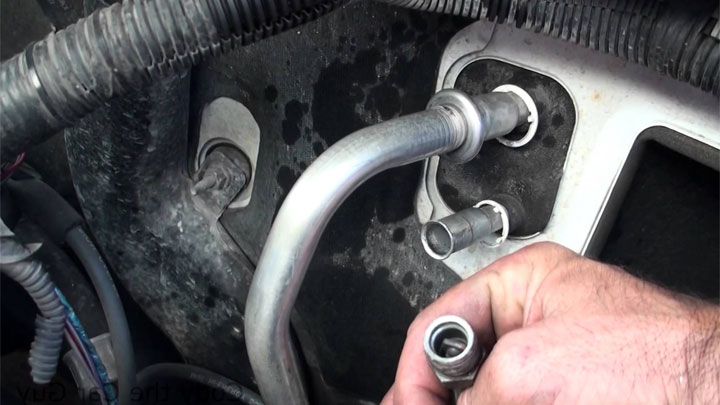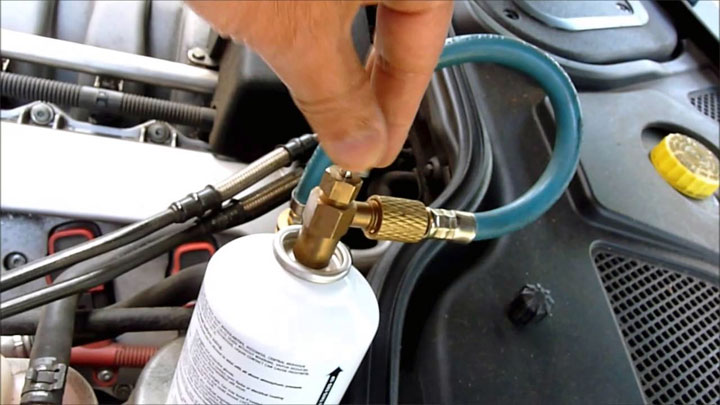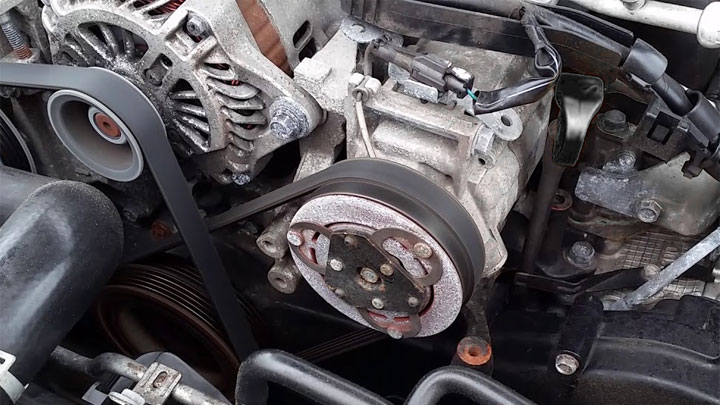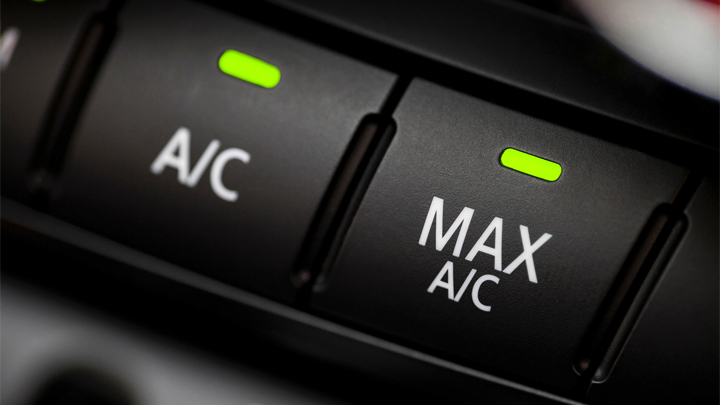8 Reasons Why Your Car’s A/C Is Not Blowing Cold Air
Air conditioning combats summer’s scorching heat during drives. But like any mechanical system, a vehicle’s A/C is prone to occasional malfunction, at the hands of individual component failure.
Read on to learn about the most common causes of a car A/C not blowing cold air anymore and how much it’s going to cost to fix it.

Related: 3 Causes of a Clogged Heater Core
Causes of a Car AC Not Blowing Cold Air
The following are several of the most common causes behind inefficient A/C system operation and cooling.
#1 – Low Refrigerant

Low refrigerant is by far the single most common cause of poor A/C cooling. This low refrigerant level is often caused by a previously undiscovered leak within the system. In any event, the offending leak should be located and repaired as necessary, prior to system recharging.
#2 – Excess Refrigerant
While not as common as a low refrigerant condition, an A/C system’s efficiency can be stifled by excessive pressures. These higher than average pressures are often caused by system overcharging.
This generally occurs when a motorist attempts to introduce additional refrigerant into their vehicle’s A/C system, with the assistance of an at-home charging kit.
#3 – System Restrictions

Restrictions within the A/C system can also serve as the root cause behind poor cooling. A restriction stifles refrigerant flow, often leading to inadvertent variances in system pressures. As a result, cooling often suffers quite dramatically.
Related: How to Clean a Cabin Air Filter
#4 – Air/Moisture Contamination

A vehicle’s A/C system must be free of air/moisture contamination in order to operate at peak efficiency. Even the smallest amount of air/moisture will cause erratic pressures within an A/C system.
Air is often inadvertently introduced into such a system, during the use of an at-home charging kit. Excess moisture can also damage the desiccant found within the system’s receiver/drier or accumulator.
#5 – Damaged Compressor

A compressor, which pressurizes an A/C system’s refrigerant, can quickly fail if starved for oil. When this occurs, all cooling ceases on the spot, and temperatures within a car’s cabin begin to rise.
One is also advised to flush the remainder of the A/C system, after experiencing an internal A/C compressor failure.
#6 – Clutch Failure
An A/C compressor relies upon the use of a clutch, which engages upon command to drive the rest of the unit’s internal components. This clutch is magnetically actuated and is released back into the free-wheel position when all power is withdrawn.
When an A/C clutch fails, engagement of the system’s compressor will become impossible.
Related: A/C Clutch No Engaging (8 Possible Causes)
#7 – Faulty Cooling Fan

Cooling efficiency can also suffer at the hands of an non-operational condenser fan. The condenser requires adequate airflow at all times, to keep high side system pressures in check.
If your vehicle is not blowing cold air when idling, yet cools as designed when accelerating, a faulty cooling fan is almost always to blame.
#8 – Malfunctioning Sensors
If any of an A/C system’s numerous sensors were to fail, the operation would be adversely affected. The vehicle’s computer would face significant difficulty when attempting to determine correct compressor clutch duty cycles.
How Much Will It Cost to Fix?
The exact cost of A/C system repair can vary greatly and is often dependent upon the type/extent of failure at hand. Additionally, the retail price of individual components within a vehicle’s A/C system can differ significantly from one make or model to the next.
In general, one can expect to pay somewhere in the ballpark of $150-$300 to have their A/C system recharged with refrigerant. This assumes no major system leaks are present, and that refrigerant levels have only decreased due to gradual loss over the course of several years.
On the other hand of the spectrum, one can expect to pay significantly more in the event of an internal A/C compressor failure. When this occurs, the system itself must be flushed, prior to the installation of a new compressor.
The system’s metering device and receiver/dryer (or accumulator) should also be replaced. Including labor, a job of this caliber typically costs an average of $500-$1,100.
How a Car Air Conditioning System Works

A vehicle’s A/C system cools cabin air by cycling refrigerant through a closed loop, in various physical states. Each of these changes in state directly correlates to temperature/pressure fluctuations within the system.
In order to facilitate proper operation, a vehicle’s A/C system must contain the proper amount of refrigerant, and be free of atmospheric air contamination.
See Also: Does A/C Use Gas or Electricity?
Main Components
Such systems are also reliant upon a number of key components, each of which serves a vital function. These components, as well as their general purpose, are as follows.
#1 – A/C Compressor
The A/C compressor is responsible for pressurizing and cycling the system’s refrigerant. This component features a magnetic clutch, which is engaged when called upon by switched input or electronic demand.
#2 – Condenser
An A/C system’s condenser is a thin, radiator-like device that is mounted behind a vehicle’s grill. When air passes across the condenser, the refrigerant within switches from a gas to liquid in state, thereby shedding heat along the way.
#3 – Dryer/Accumulator
Depending upon the type of A/C system in use, your vehicle features either an accumulator or receiver dryer. The former of these devices is found only in orifice tube systems, while the latter is a main component in expansion valve systems.
These devices contain industrial-grade desiccant, which absorbs wayward moisture from within the system.
#4 – Metering Device (Orifice Tube/Expansion Valve)
All automotive A/C systems rely upon a specialized metering device to dictate the refrigerant flow. Many of these systems utilize an orifice tube to complete this chore, while others use an expansion valve.
The exact location of these metering devices differs based upon system type.
#5 – Evaporator Core
An A/C system’s evaporator core is a compact heat exchanger, which is mounted beneath a vehicle’s dash. Refrigerant passing through a vehicle’s condenser switches from liquid to gas in state, as it gathers heat from within the cabin.
Sensors
Outside of these main components, an A/C system also contains several sensors, all of which provide valuable feedback that is necessary for proper system operation. These sensors, as well as their general purpose, are as follows.
#1 – Low Pressure Switch
A low pressure switch is designed to detect a relative loss in refrigerant, as well as the lubricating oil that accompanies it. When low-side system pressures drop below a specified value, the low pressure switch is tripped to disable the system’s compressor, thereby minimizing the risk of failure.
#2 – High Pressure Switch
A high pressure switch is specifically designed to detect the over-pressurization of refrigerant within an A/C system. When system pressures spike for any number of reasons, the high pressure switch is tripped, thereby interrupting compressor clutch operation.
#3 – Ambient Temperature Sensor
Modern automotive A/C systems utilize an ambient temperature sensor to relay cabin temperatures in real-time. This information is used to increase cooling efficiency, and to maintain stable cabin temperatures under a wide range of conditions.
How to Prevent Future A/C Problems

In some cases, A/C system-related failures are unavoidable. However, in other instances, such issues can be largely avoided with simple maintenance. This most notably includes having your vehicle’s A/C system serviced at factory specified intervals. For many makes and models, this service interval is generally around the 100,000-mile mark.
Related: How to Prevent Smells Inside Your Car
A basic A/C service typically involves ensuring that your system is filled to capacity with refrigerant and that no obvious leaks are found. A service technician will connect a set of gauges to your vehicle’s A/C charging ports, before reading the system’s high and low pressures. This will provide the technician with information regarding the system’s rate of charge.
If these pressures are lower than intended, the system’s refrigerant will be topped off, or alternatively, evacuated and recharged. A technician will also seek out the source of any offending leaks with a UV light. Repairs can then be made as necessary.
A preventative A/C service, such as that described above, is quite valuable when intended to extend the service life of various components within your vehicle’s A/C system.
Services of this type prevent your vehicle’s A/C system from running low on refrigerant, which will cause a compressor to short cycle on an ongoing basis. This short cycling ultimately accelerates the wear of the A/C compressor’s internal components, as well as its magnetic clutch assembly.
- 5 Symptoms of an EVAP Leak (and Repair Cost) - Apr 27, 2024
- P0480 Code (Symptoms, Causes, and How to Fix) - Apr 19, 2024
- Car Temperature Gauge Stopped Working? (Here’s Why) - Apr 15, 2024

I was told there are 2 fuses for the a/c one at the fuse box10amp and a 30amp fuse on the firewall? I’m having trouble finding the 30 amp fuse. Do you have images of the 30 amp fuse location, on a C2 1966 Corvette Coupe? thank you. Ed.
Unfortunately no, I don’t have images of fuse locations on every car. I would ask in a C2 owner’s forum, or perhaps a C2 owner’s group on Facebook. I am pretty sure someone in one of those groups will know the answer and be able to provide you a picture from their own car.